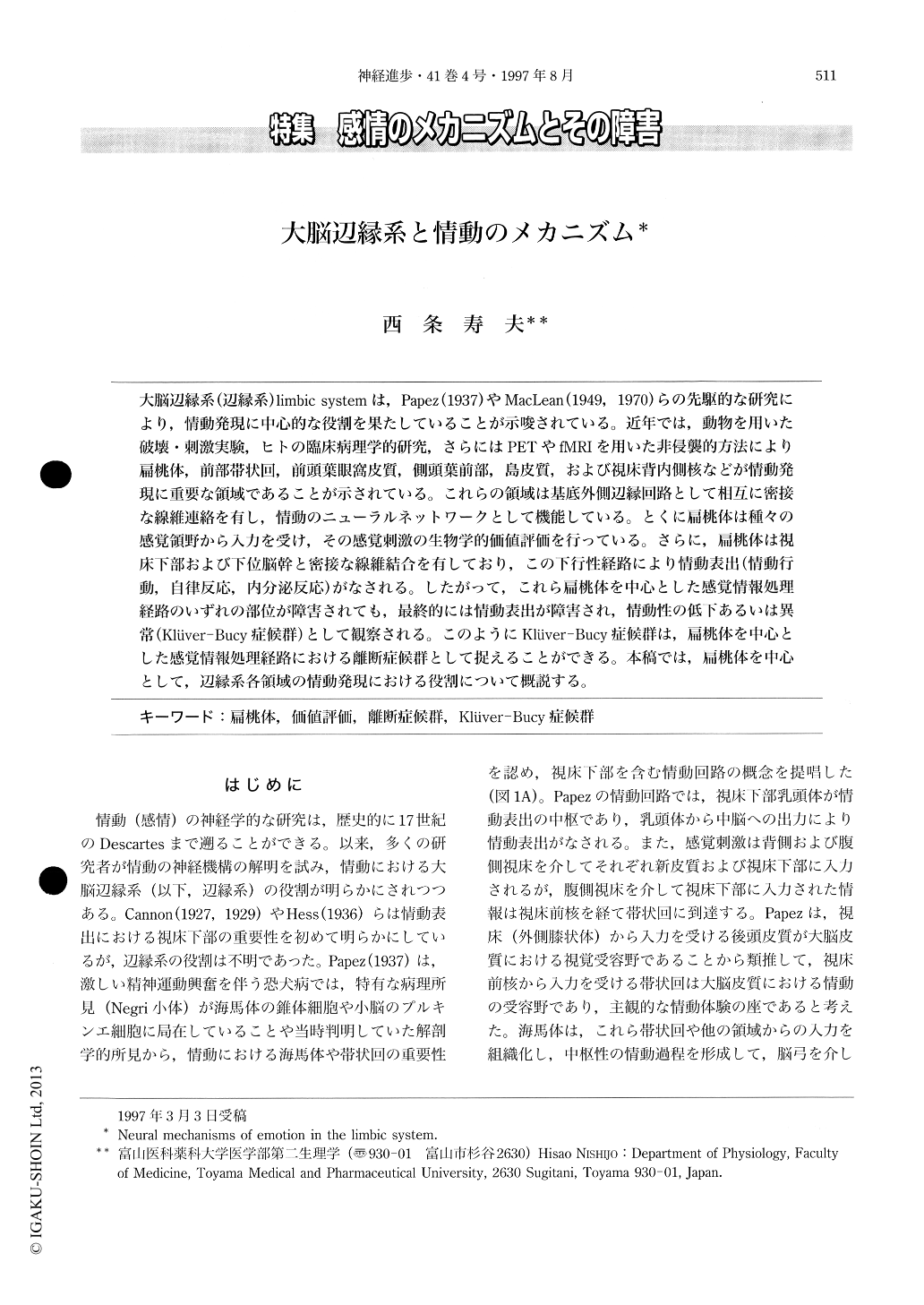Japanese
English
- 有料閲覧
- Abstract 文献概要
- 1ページ目 Look Inside
大脳辺縁系(辺縁系)limbic systemは,Papez(1937)やMacLean(1949,1970)らの先駆的な研究により,情動発現に中心的な役割を果たしていることが示唆されている。近年では,動物を用いた破壊・刺激実験,ヒトの臨床病理学的研究,さらにはPETやfMRIを用いた非侵襲的方法により扁桃体,前部帯状回,前頭葉眼窩皮質,側頭葉前部,島皮質,および視床背内側核などが情動発現に重要な領域であることが示されている。これらの領域は基底外側辺縁回路として相互に密接な線維連絡を有し,情動のニューラルネットワークとして機能している。とくに扁桃体は種々の感覚領野から入力を受け,その感覚刺激の生物学的価値評価を行っている。さらに,扁桃体は視床下部および下位脳幹と密接な線維結合を有しており,この下行性経路により情動表出(情動行動,自律反応,内分泌反応)がなされる。したがって,これら扁桃体を中心とした感覚情報処理経路のいずれの部位が障害されても,最終的には情動表出が障害され,情動性の低下あるいは異常(Klüver-Bucy症候群)として観察される。このようにKlüver-Bucy症候群は,扁桃体を中心とした感覚情報処理経路における離断症候群として捉えることができる。本稿では,扁桃体を中心として,辺縁系各領域の情動発現における役割について概説する。
In the present paper, roles of various areas in the limbic system in emotion were reviewed. The limbic system has been implicated in a pivotal role in emotion since pioneering studies by Papez (1937) and MacLean (1940, 1970). Recent studies with electrical stimulation and lesions using animals, clinicopathological studies in humans, and non-invasive studies with PET and fMRI in humans indicated that the amygdala, anterior cingulate cortex, prefrontal orbital cortex, anterior temporal cortex, insula, and mediodorsal thalamic nucleus were crucial areas in emotion. These areas have mutual intimate anatomical connections and compose the basolateral limbic circuit, and work as a neural network of emotion. In this network, the amygdala receives multimodal inputs from various sensory association cortices, and is involved in evaluation of biological significance of a stimulus. In turn, the amygdala heavily projects to the hypothalamus and lower brainstem involved in emotional expression (i.e., emotional behaviors, autonomic responses, and hormonal release). Therefore, any disturbance or lesions in the sensory pathway from sensory association cortices to the brainstem including the hypothalamus through the amygdala will induce hypoemotionality or abnormal behaviors (e.g., Klüver-Bucy syndrome). This suggests that Klüver-Bucy syndrome is interpreted in terms of disconnection syndrome. Roles of other areas in the basolateral limbic circuit in emotion were discussed in reference to recent studies in humans with PET and fMRI.

Copyright © 1997, Igaku-Shoin Ltd. All rights reserved.


